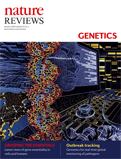|
| TABLE OF CONTENTS | |||||||||||||||||||||||||||||||||||||
| January 2018 Volume 19 Number 1 | |||||||||||||||||||||||||||||||||||||
| In this issue
| | |||||||||||||||||||||||||||||||||||
| |||||||||||||||||||||||||||||||||||||
 | |||||||||||||||||||||||||||||||||||||
| Advertisement | |||||||||||||||||||||||||||||||||||||
| |||||||||||||||||||||||||||||||||||||
| EDITORIAL | Top | ||||||||||||||||||||||||||||||||||||
| Putting gene essentiality into context p1 | doi:10.1038/nrg.2017.141 Full Text | PDF | |||||||||||||||||||||||||||||||||||||
| |||||||||||||||||||||||||||||||||||||
| Advertisement | |||||||||||||||||||||||||||||||||||||
| |||||||||||||||||||||||||||||||||||||
| REVIEWS | Top | ||||||||||||||||||||||||||||||||||||
Towards a genomics-informed, real-time, global pathogen surveillance system Jennifer L. Gardy & Nicholas J. Loman p9 | doi:10.1038/nrg.2017.88 Next-generation sequencing has the potential to support public health surveillance systems to improve the early detection of emerging infectious diseases. This Review delineates the role of genomics in rapid outbreak response and the challenges that need to be tackled for genomics-informed pathogen surveillance to become a global reality. Abstract | Full Text | PDF | |||||||||||||||||||||||||||||||||||||
| Navigating complexity to breed disease-resistant crops Rebecca Nelson, Tyr Wiesner-Hanks, Randall Wisser & Peter Balint-Kurti p21 | doi:10.1038/nrg.2017.82 Disease-resistant crops have the potential to reduce crop losses. This Review discusses how advances in genetic and genomic technologies are contributing to efforts by plant breeders to generate durable, broad-spectrum disease resistance in crop plants. Abstract | Full Text | PDF | Supplementary information | |||||||||||||||||||||||||||||||||||||
| Emerging and evolving concepts in gene essentiality Giulia Rancati, Jason Moffat, Athanasios Typas & Norman Pavelka p34 | doi:10.1038/nrg.2017.74 Identifying which genes in a genome are essential for survival has been a long-standing goal of geneticists. This Review discusses our evolving understanding of cellular gene essentiality across diverse organisms. It describes how essentiality is often non-absolute but is instead dependent on the environment or genetic background and how this knowledge can be exploited therapeutically. Abstract | Full Text | PDF | Supplementary information | |||||||||||||||||||||||||||||||||||||
| Advertisement | |||||||||||||||||||||||||||||||||||||
| |||||||||||||||||||||||||||||||||||||
| ANALYSIS | Top | ||||||||||||||||||||||||||||||||||||
| Human gene essentiality Istvan Bartha, Julia di Iulio, J. Craig Venter & Amalio Telenti p51 | doi:10.1038/nrg.2017.75 Characterizing the essentiality of human genes provides insights into gene function and genome evolution and facilitates the clinical interpretation of genetic variants. This article analyses essentiality metrics based on the statistical intolerance to loss-of-function mutations in human population sequencing studies and discusses commonalities and distinctions relative to data sets from knockout mice and functional genomics screens in human cell culture. Implications for disease genetics and extrapolation to non-coding regions are also discussed. Abstract | Full Text | PDF | Supplementary information | |||||||||||||||||||||||||||||||||||||
| |||||||||||||||||||||||||||||||||||||
| You have been sent this Table of Contents Alert because you have opted in to receive it. You can change or discontinue your e-mail alerts at any time, by modifying your preferences on your nature.com account at: www.nature.com/myaccount For further technical assistance, please contact our registration department For print subscription enquiries, please contact our subscription department For other enquiries, please contact our feedback department Springer Nature | One New York Plaza, Suite 4500 | New York | NY 10004-1562 | USA Springer Nature's worldwide offices: Macmillan Publishers Limited is a company incorporated in England and Wales under company number 785998 and whose registered office is located at The Campus, 4 Crinan Street, London, N1 9XW. © 2018 Macmillan Publishers Limited, part of Springer Nature. All Rights Reserved. |
 |









No comments:
Post a Comment